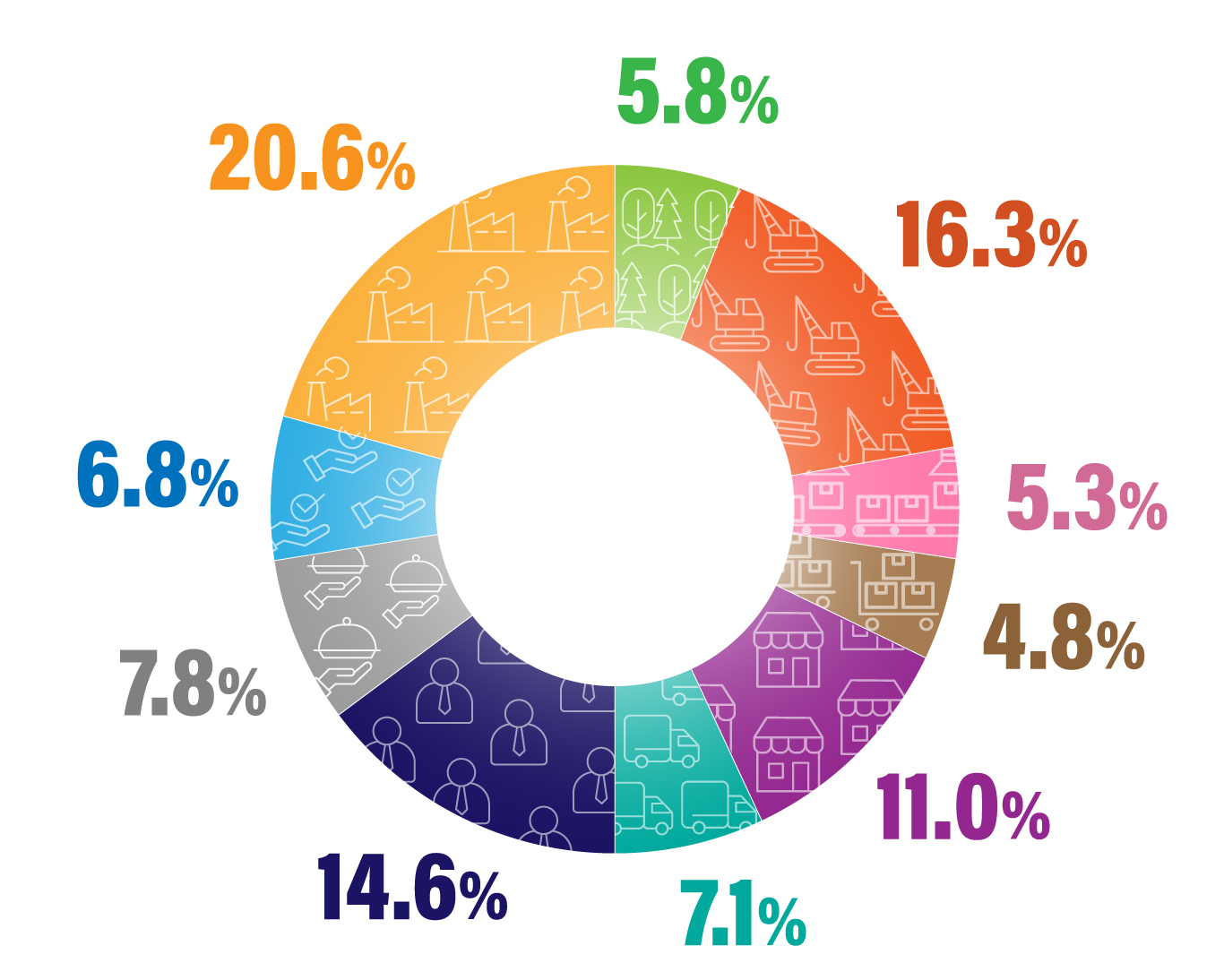

June 27 is National Micro-, Small and Medium-sized Enterprises Day, recognized internationally for their contributions to employment.
In Canada, small- and medium-sized enterprises (SMEs) account for the largest proportion of the labour force, and chances are, many of your family, friends and neighbours work for one.
The Survey on Financing and Growth of Small and Medium Enterprises considers a small enterprise as one with fewer than 100 employees, including those that do not report any employment. Medium-sized enterprises have 100 to 499 employees, and a large one has over 500.
Small- and medium-sized businesses made up nearly all (98.1%) employer businesses in Canada in 2021.

Description - Weighted enterprise counts
|
Agriculture, forestry, fishing and hunting, mining and oil and gas extraction |
5.8 |
|
Construction |
16.3 |
|
Manufacturing |
5.3 |
|
Wholesale trade |
4.8 |
|
Retail trade |
11.0 |
|
Transportation and warehousing |
7.1 |
|
Professional, scientific and technical services |
14.6 |
|
Accommodation and food services |
7.8 |
|
Other services |
6.8 |
|
Other industries from the North American Industrial Classification System |
20.6 |

The highest proportion of SMEs in one industry was in construction (16.3%), followed by professional, scientific and technical services (14.6%), retail trade (11%), accommodation and food services (7.8%), and transportation and warehousing (7.1%). Over one-fifth (20.6%) of SMEs were in a broader category of multiple industries such as real estate, waste management and remediation services, health care and social assistance, and arts, entertainment and recreation.
A lower share of SMEs (6.8 %) were among service industries for repair and maintenance, personal and laundry, religious, grant-making, civic and other services. Another 5.8% of SMEs were in the agriculture, forestry, fishing and hunting, and mining and oil and gas extraction industry. Meanwhile, 5.3% of SMEs were in manufacturing, and 4.8% of SMEs were in wholesale trade.

In 2020, over one-quarter (28.7%) of primary decision-makers of Canadian SMEs were born outside of Canada, and close to 20% of them had a mother tongue other than English or French.
In the same year, over 4 in 10 SMEs had some proportion of female ownership. Nearly 15% (14.3%) of SMEs were fully owned by women, and another 14.3% had 50% female ownership.
Ownership in general of SMEs suggests a lot of ambition among Canadians. In 2020, over 3 out of every 4 existing SMEs (75.5%) were started from scratch.


Weathering pandemic, financing and supply challenges
Statistics Canada recently reported that SMEs led the ongoing recovery from the COVID-19 pandemic in the number of importers and exporters.
Although they accounted for less than half (45.9%) of Canada’s trade value, the vast majority (98.8%) of traders were SMEs. The rise in exporting enterprises in 2021 was led by SMEs that exported exclusively to the United States, Canada’s largest trading partner.
Over four-fifths (82.4%) of SMEs requested external financing in 2020, largely due to the pandemic, and up from about half (47.1%) in 2017. This included requests for a non-residential mortgage, loan, business line of credit or other types of credit. More than three-quarters (75.9%) of SMEs requested government financing in 2020.
Over one-quarter (28.2%) of overall businesses expect difficulty in acquiring inputs, products or supplies domestically over the next three months. Of these businesses, almost three-fifths (57.2%) expect these challenges to persist over six months or more.


Patents, intellectual property and innovation
The contribution of SMEs to patent applications has grown over time, particularly for small enterprises.
In 2001, the share of applications for small enterprises (43%) was nearly identical to that of large enterprises (42%). By 2015, the contribution of small enterprises had grown to 55%, while the contribution of large enterprises had fallen to 33%.
Intellectual property (IP) ownership among Canadian SMEs also accounts for a significant share.
Nearly 1 in 5 (18%) of Canadian enterprises owned at least one IP in or outside of Canada in 2019. This proportion varies by business size. It is nearly half (48.9%) for businesses with 100 to 499 employees; over 1 in 5 (20.7%) for businesses with 20 to 99 employees; and 13.5% for those with 1 to 4 employees.
In 2020, Canadian SMEs reported innovation activity in the last three years, for a new or significantly improved good or service (16.4%); production process or method (8.3%); new organizational method in business practices, workplace organization or external relations (8.6%); and a new way of selling goods and services (9.2%).


Looking ahead
Despite the unprecedented challenges of the pandemic for much of 2020, in that year, over 3 in 4 (75.1%) SMEs did not intend to sell, transfer or close the business in the next five years, while another quarter (24.9%) did intend to do so.
Retirement age could be a factor in any such plans, as in 2020, nearly half (46.9%) of SMEs had decision makers aged 50 to 64 years, and nearly 15% were over 65.
Contact information
For more information, contact the Statistical Information Service (toll-free 1-800-263-1136; 514-283-8300; infostats@statcan.gc.ca) or Media Relations (statcan.mediahotline-ligneinfomedias.statcan@statcan.gc.ca).
